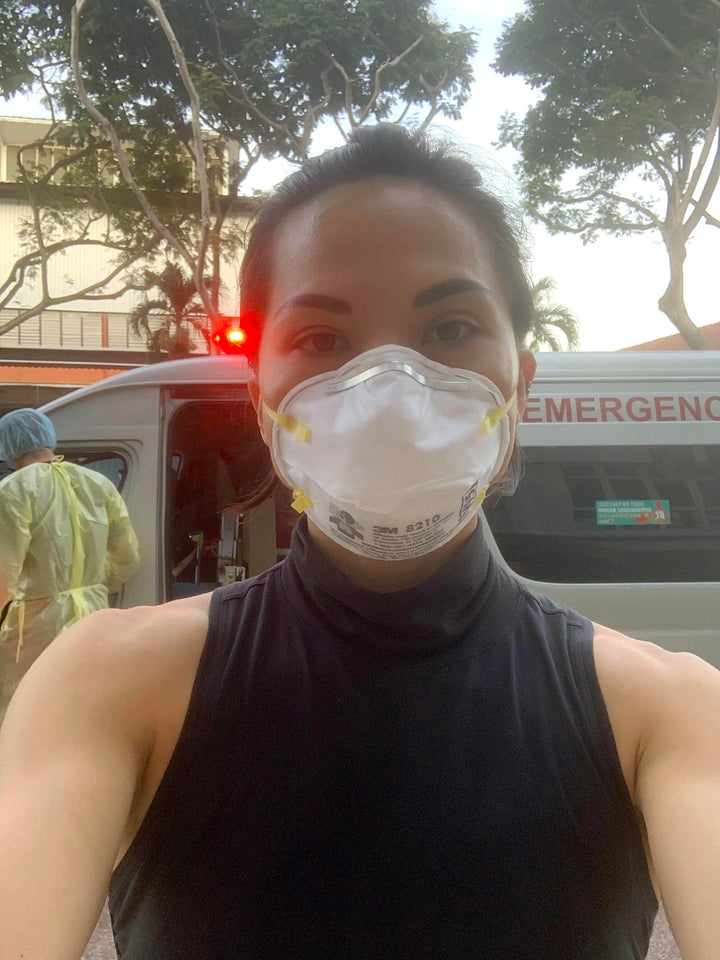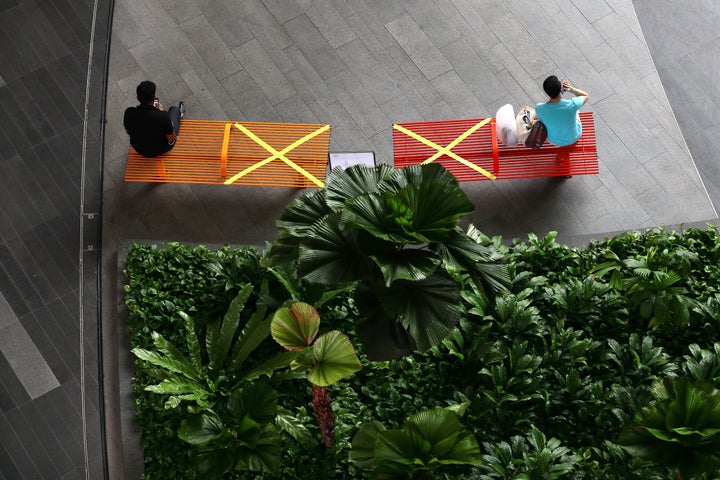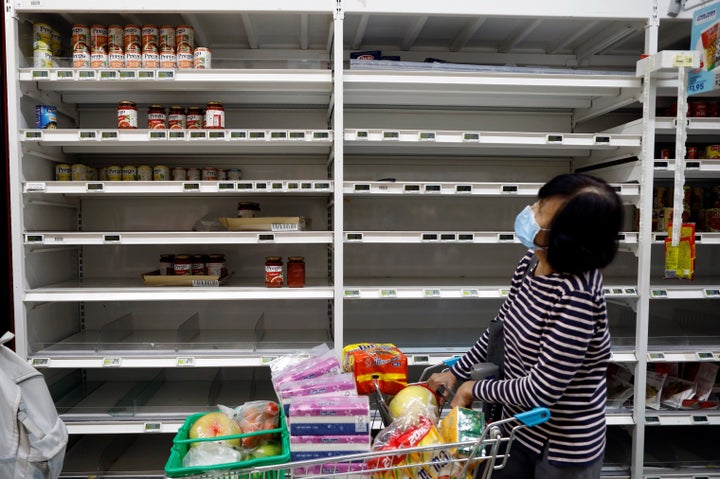SINGAPORE — At around 4 p.m. on March 26, a Thursday, I got a text message from the yoga studio where I moonlight as a part-time instructor. A student who’d been in one of my classes a week earlier had tested positive for the coronavirus. Be prepared to be quarantined, the studio boss warned me.
Oh, he added, the Ministry of Health will be contacting you soon.
He wasn’t kidding. Within the hour, a ministry representative conducting contact tracing for coronavirus cases called my cellphone. After I told her about some shortness of breath I’d experienced in the prior two days, an ambulance was immediately dispatched to my home and I was whisked to the National Center for Infectious Diseases to be tested for the virus known as COVID-19. By 8:30 p.m., my chest had been X-rayed, nose swabs to test for the coronavirus administered and a brief examination by an emergency room doctor completed.
The doctor told me my X-ray showed no sign of pneumonia and, as I had no other symptoms of the virus and was asthmatic but had no other chronic conditions, she said she thought I may have had an asthma attack, triggered possibly by stress, rather than been stricken with COVID-19. Still, she instructed me to return home to self-quarantine in my room and to await my test results.
I got home around 9 p.m. — five hours after I’d first learned of potential exposure to the coronavirus. Within 36 hours, I got my test results in a text message: Negative.

My experience is typical of someone potentially exposed to the coronavirus in Singapore, the tiny but influential city-state in Southeast Asia that’s been held up by health experts as a gold standard of COVID-19 mitigation. With its port and airport among the world’s busiest, a dense population and close ties to China, where the coronavirus originated, Singapore was always at high risk of becoming a virus hotspot. Indeed, in the early days of the pandemic, Singapore had among the world’s highest number of COVID-19 cases.
But three months into the outbreak here, Singapore’s numbers remain relatively low ― thanks in part to swift action early on to impose travel restrictions, and to a robust carrots-and-sticks strategy of mitigation that involves rigorous contact tracing, widespread testing and restrictive border controls. Starting last week, Singapore has been under a strict lockdown, similar to those seen in Europe and the United States. The country initially resisted shutting down entirely ― though increasingly restrictive and rigidly enforced social distancing measures have been rolled out from week to week.
To date, Singapore, with a population of 6 million, has had about 3,700 people infected. Ten have died.
Compare that to my mom’s home state of Washington, which has a population of around 7.5 million. The state reported the first confirmed coronavirus case in the U.S. in late February, about a month after Singapore’s first patient. Washington has since recorded over 10,700 COVID-19 cases and 567 deaths. In New York, a state I called home for a decade before moving to Singapore, over 200,000 cases have been reported; more than 11,000 people have perished.
Singapore is only about a quarter of the size of Rhode Island and is ruled by what’s essentially one-party government, so it’s impossible to make an apples-to-apples comparison with the United States. But with President Donald Trump itching to reopen the American economy and widespread uncertainty about how to do that without risking lives and the collapse of the health care system, experts have pointed to Singapore’s methodical strategy of dealing with its own outbreak as a possible guidebook.
“All the things that Singapore has in place, any country under lockdown will need to do these, or implement these during lockdown, so that they can be safe afterwards,” Dale Fisher, chair of the World Health Organization’s Global Outbreak Alert and Response Network, told CNBC last month.

The country’s meticulous contact tracing efforts have been pinpointed as a key factor in its successful battle against the virus. A team of more than 100 dedicated contact tracers spend nine hours a day calling people — like me — who may have been exposed to COVID-19. If any of the people contacted have worrying symptoms, they’re immediately sent for testing.
To date, 72,680 COVID-19 tests have been administered in Singapore. That’s a rate of about 12,800 tests per million people; in the U.S., that rate currently stands at around 8,600 tests per million.
The BBC reported in March that 40% of positive coronavirus cases in Singapore had been identified because of contact tracing efforts. A few weeks earlier, epidemiologists at the Harvard T.H. Chan School of Public Health described Singapore’s approach to COVID-19 as the “gold standard of near-perfect detection.”
If you test positive for the virus here, you’re immediately hospitalized and isolated. You’re then kept sequestered at either a hospital or a dedicated quarantine facility until multiple tests for COVID-19 come up negative — and all this on the government’s dime.
If you test negative in the first place, as I did, you still have to remain quarantined at home for 14 days from the date of possible exposure — 14 days being the estimated incubation period of the virus. Quarantine orders or stay-home notices, the latter of which has fewer legal ramifications, are issued to all Singaporeans and residents traveling back into the country, regardless of the origin of their travel. All short-term visitors have been banned from entering Singapore for several weeks.
A staggering 65,000 stay-home notices have been issued to date, according to the Ministry of Health. More than 28,000 quarantine orders have been issued.
Dr. Anthony Fauci, the top U.S. infectious disease expert, suggested earlier this month that a two-prong approach of more widespread testing and more contact tracing could help allow the U.S. to gradually ease restrictions like stay-at-home orders.
“The one thing we hopefully would have in place, and I believe we will have in place, is a much more robust system to be able to identify someone who’s infected, isolate them and then do contact tracing,” Fauci said. “If you have a really good program of containment, that prevents you from ever having to get into mitigation. We’re in mitigation right now.”
But as with other countries that have come under scrutiny for intrusions into citizens’ privacy and civil liberties in their battles against COVID-19, Singapore — where politics has been dominated by a single party since its independence in the 1960s — has faced criticisms of paternalism.
Defying quarantine and stay-home orders can result in heavy penalties. One man was stripped of his permanent residency status after he breached a stay-home notice and was permanently barred from entering Singapore. People caught flouting their quarantine orders could face up to $10,000 in fines and six months behind bars.
When I was under quarantine, a police officer came to my door to serve me an official notice, informing me of the potential legal ramifications if I dared step foot out of my room. He also gave me a zip-lock bag containing two surgical masks and a thermometer. From that point on, I received a phone call three times daily from a Ministry of Health representative. It was always in the form of a one-way video call, to allow the representative to have a look at my surroundings — to ensure I was home. They would ask for my temperature and any worrying symptoms. It felt intrusive, to say the least; disconcerting to have a stranger I could not see peer inside the most intimate of personal spaces.
So-called safe distancing ambassadors roam the streets to ensure people are social distancing and abiding by the rules of Singapore’s lockdown ― rebranded here as a “circuit breaker” when it kicked in April 7 after weeks of increasingly restrictive social distancing measures.
Any rule-breakers are immediately fined $300. The Health Ministry said Tuesday that more than 500 people had been penalized over a two-day period.
Like China and Israel, Singapore has also used mass surveillance tools like security cameras and drones to track down potential virus carriers and to monitor social distancing efforts ― prompting some critics to label it a police state.
Asked by CNN’s Fareed Zakaria last month to respond to criticisms of paternalistic controls, Singapore Prime Minister Lee Hsien Loong said the government had “not taken extraordinary powers” against COVID-19.
“I think the key thing is people must understand what we are facing and must support what we are doing, cooperate with us, and have confidence in the government. We put a lot of effort into explaining to them what is happening, speaking to them and I have done it a few times directly on television, so people know that we are level and we tell it straight,” Lee said.
“We are transparent ― if there is bad news, we tell you. If there are things which need to be done, we also tell you. I think that you have to maintain that trust, because if people do not trust you ― even if you have the right measures ― it is going to be very hard to get it implemented,” he continued.
Indeed, some observers have praised Lee and his government for effective communication during this crisis. In February, after Singapore raised its outbreak alert level to orange ― just one notch below the maximum of red ― Singaporeans flocked to supermarkets and, in a panic-buying frenzy, emptied shelves.
Lee responded by immediately addressing the nation and explaining in detail the country’s coronavirus strategy. He also reassured the public that there was plenty of food.
“We have ample supplies, so there is no need to stock up with instant noodles, tinned food, or toilet paper,” he said.
As Time magazine noted, the speech appeared to have had an immediate effect ― with supermarkets reporting a return to more normal buying habits among customers.
“It’s one of the most beautiful pieces of risk communication I have ever seen,” Claire Hooker, a public health expert at University of Sydney, told Time of Lee’s address to Singaporeans. “In order to be trusted you need to be open and honest and transparent. You need to demonstrate your competence, and you need to show people that you actually care.”

Singapore may have done a lot of things right in its fight against the coronavirus, but it is far from out of the woods.
On Wednesday, the country reported its highest single-day jump in COVID-19 cases, with 447 new infections. Singapore is now in the midst of an infection surge.
A majority of the new cases involve migrant workers living in dormitories. The infections have cast a harsh light on the staggering inequality experienced by hundreds of thousands of low-wage laborers who live in cramped, overcrowded dorms on the outskirts of affluent Singapore.
Still, health experts believe the U.S. and other nations could learn from Singapore’s experience.
“Singapore’s methods are designed to meet Singapore’s needs, but countries seeking to learn from Singapore’s experience should distill the core principles and decide on adaptation to meet their own needs,” Jeremy Lim, co-director of the Leadership Institute for Global Health Transformation at the National University of Singapore, told HuffPost this week.
Trump and other world leaders could also learn from Lee’s pragmatism.
When asked by CNN’s Zakaria about Singapore’s “success” in containing COVID-19, Lee insisted the fight was far from over.
A “great effort ... has helped to keep the number of cases down, but I am under no illusions that we have won,” the prime minister said. “We are just going in, and there is a long battle ahead.”
Within days of his remarks, the number of cases in Singapore ― where the curve of infections had already flattened significantly ― began to rise steeply again as dormitory cases surged.
Lee warned that it could take many months, if not years, for COVID-19 to be truly contained globally ― unless a vaccine is found and disseminated quickly.
“I am not a professional epidemiologist or infectious disease specialist, but I do not see this problem going away in a couple of months,” Lee said.
- Stay up to date with our live blog as we cover the COVID-19 pandemic
- What happens if we end social distancing too soon?
- What you need to know about face masks right now
- How long are asymptomatic carriers contagious?
- Lost your job due to coronavirus? Here’s what you need to know.
- Everything you need to know about coronavirus and grief
- The HuffPost guide to working from home
- What coronavirus questions are on your mind right now? We want to help you find answers.
- Everyone deserves accurate information about COVID-19. Support journalism without a paywall — and keep it free for everyone — by becoming a HuffPost member today.

